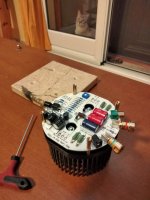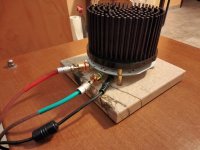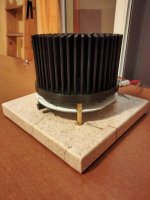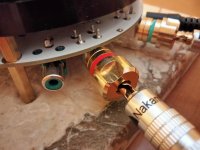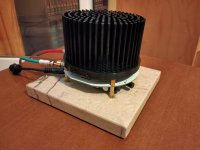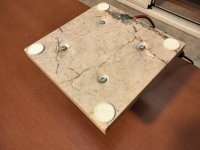Something of NCC-1701 🖖🤣
Nelson Brock's original photos included many clever ideas and cute implementation choices that I gladly copied when I built my pair of monoblock amps. Including
* Soldering the speaker binding post's M4 threaded bolt, to the 90 degree mounted PCB connector. Now it can't vibrate out.
* Using black nylon spacers for the final four "legs" that touch the tabletop which supports the weight of the monoblock. Nylon is less likely to scratch wood or glass, than metal.
_
* Soldering the speaker binding post's M4 threaded bolt, to the 90 degree mounted PCB connector. Now it can't vibrate out.
* Using black nylon spacers for the final four "legs" that touch the tabletop which supports the weight of the monoblock. Nylon is less likely to scratch wood or glass, than metal.
_
Yes, but I cannot find them here. I'd like to try some nice drawer handles, as they have an M4 thread.Using black nylon spacers for the final four "legs" that touch the tabletop which supports the weight of the monoblock. Nylon is less likely to scratch wood or glass, than metal.
_
Little test yesterday with my pal Benny's Cornwalls: STUNNING!



I like how the perspective of the photo hides the back legs of the racks. Looks like they're defying gravity!
Mine are nearly built
Mine are nearly built
No.
That's not even an Amp Camp Amp. It's an Aleph J. Look at the silkscreen text at center bottom. Notice the "24W" claim in the title.
There are no mounting holes on the PCB to attach it to a "hedgehog" heatsink. It appears they intend for the board to be suspended only by the leads of the power transistors at the Northeast, Southeast, Southwest, and Northwest perimeter.
On the other hand it does vividly demonstrate the value of being able to lay out your own PCBs starting from a Nelson Pass schematic. If you made your own layout, you could fab twenty of these boards, and have them shipped to your house by DHL International Express, for the same price+shipping as two boards from these counterfeiters.
_
That's not even an Amp Camp Amp. It's an Aleph J. Look at the silkscreen text at center bottom. Notice the "24W" claim in the title.
There are no mounting holes on the PCB to attach it to a "hedgehog" heatsink. It appears they intend for the board to be suspended only by the leads of the power transistors at the Northeast, Southeast, Southwest, and Northwest perimeter.
On the other hand it does vividly demonstrate the value of being able to lay out your own PCBs starting from a Nelson Pass schematic. If you made your own layout, you could fab twenty of these boards, and have them shipped to your house by DHL International Express, for the same price+shipping as two boards from these counterfeiters.
_
Quick question: I have 4 unmatched IRFP240 lying around that I bought a while ago. How much of a difference will it make to the sound if I use these instead of buying another matched quad?
Great, thanks for the responses!
Just ordering parts now, do you think these would be suitable for the inductors https://www.mouser.co.uk/ProductDetail/Vishay/IHTH1500MZEB2R2M5A?qs=pBJMDPsKWf0z%2BEvRAc/TZw== ??
Also, do I need to choose a non-conductive m3 washer for the mosfets?
Just ordering parts now, do you think these would be suitable for the inductors https://www.mouser.co.uk/ProductDetail/Vishay/IHTH1500MZEB2R2M5A?qs=pBJMDPsKWf0z%2BEvRAc/TZw== ??
Also, do I need to choose a non-conductive m3 washer for the mosfets?
One point about having young people (actual young people not people like Zen Mod) build simple amps is that their tiny fingers and great eye/hand coordination makes handling and soldering small components rather easy for them. Not to mention that they can read the tiny text on components. This makes using resistors with the values labeled on them a good idea. However, like all of us they should use a meter to confirm values, and especially be aware of how important the “k” is if in a value. Measuring the resistors adds another dimension, and they like using the meter. A quick soldering lesson is essential, but they catch on quickly!
I’ve sat beside 6 and 8 year olds and acted as a co-pilot, helping find parts and double checking values, although clearly at some age they can do it completely themselves. Never had a failure and they always agree with Nelson Pass that taking a few parts and making them come alive to play music is a great thrill!
Nelson Brock’s design is another step forward- easier yet, and so cool looking, while keeping costs even lower. I call it The Hedgehog!
I’ve sat beside 6 and 8 year olds and acted as a co-pilot, helping find parts and double checking values, although clearly at some age they can do it completely themselves. Never had a failure and they always agree with Nelson Pass that taking a few parts and making them come alive to play music is a great thrill!
Nelson Brock’s design is another step forward- easier yet, and so cool looking, while keeping costs even lower. I call it The Hedgehog!
The nickname "hedgehog" was created by diyAudio member sthcoaster on January 3, 2022 in post #15 of this thread.
For people who want PCBs right now, and who are able to source components (including heatsinks) themselves, this option is available:
Not exactly a Group Buy: bare boards for RACAM (Round ACA Monoblock)
For people who want PCBs right now, and who are able to source components (including heatsinks) themselves, this option is available:
Not exactly a Group Buy: bare boards for RACAM (Round ACA Monoblock)
Respecting the non-competitive aspect of this thread, I withdraw my claim!
“Hedgehog” does tell the story. So I too say +1 for “ACA Hedgehog” for the Brock design…
“Hedgehog” does tell the story. So I too say +1 for “ACA Hedgehog” for the Brock design…
Last edited:
- Home
- Amplifiers
- Pass Labs
- ACA Redux
